Weight belts are required for scuba diving. They make the descent considerably simpler and allow you to make a quick, effortless climb anytime you need to. Weight belts are nylon belts that have lead weights attached to them. They fasten around your waist in the same way as traditional belts do.
Diving weight belts are the oldest method in use in scuba diving, and for a few divers, they are the “tried-and-true” system. These belts are fairly easy to locate and reasonably priced.
When it comes to choosing the greatest diving belt or weight, it all boils down to personal preference. The best way to choose a piece of equipment is to test it in a swimming pool. This will allow you to choose which belt or weight is most comfortable for you.
| Weight Belts | Brand | Our Rating | Check on Amazon |
|---|---|---|---|
 | Riffe - Rubber Weight Belt with Buckle | [su_button url="https://www.amazon.com/Riffe-Rubber-Weight-Freediving-Spearfishing/dp/B00CMUMS3S?tag=beka3687-20" target="blank" style="default" background="#E03F00" color="#FFFFFF" size="5" wide="no" center="no" radius="auto" icon="" icon_color="#FFFFFF" text_shadow="none" desc="" onclick="" rel="" title="" id="" class=""]Check Price[/su_button] | |
 | Cressi - Weight Belt with Quick-Release Buckle | [su_button url="https://www.amazon.com/Cressi-Nylon-Weight-Plastic-Buckle/dp/B07F455WJY?tag=beka3687-20" target="blank" style="default" background="#E03F00" color="#FFFFFF" size="5" wide="no" center="no" radius="auto" icon="" icon_color="#FFFFFF" text_shadow="none" desc="" onclick="" rel="" title="" id="" class=""]Check Price[/su_button] | |
 | Scuba Max - Nylon Zippered Weight Belt | [su_button url="https://www.amazon.com/Scuba-Max-Zippered-Pocket-Weight/dp/B005K251N4?tag=beka3687-20" target="blank" style="default" background="#E03F00" color="#FFFFFF" size="5" wide="no" center="no" radius="auto" icon="" icon_color="#FFFFFF" text_shadow="none" desc="" onclick="" rel="" title="" id="" class=""]Check Price[/su_button] | |
 | Scuba Choice - Black Vinyl Coated Diving Weight Belt | [su_button url="https://www.amazon.com/Scuba-Choice-Coated-Diving-Weights/dp/B01LZV2PV9?tag=beka3687-20" target="blank" style="default" background="#E03F00" color="#FFFFFF" size="5" wide="no" center="no" radius="auto" icon="" icon_color="#FFFFFF" text_shadow="none" desc="" onclick="" rel="" title="" id="" class=""]Check Price[/su_button] | |
 | Engineered Edge - Dive Weight Belt | [su_button url="https://www.amazon.com/Engineered-Edge-Weights-Diving-Weight/dp/B08GGZYZFL?tag=beka3687-20" target="blank" style="default" background="#E03F00" color="#FFFFFF" size="5" wide="no" center="no" radius="auto" icon="" icon_color="#FFFFFF" text_shadow="none" desc="" onclick="" rel="" title="" id="" class=""]Check Price[/su_button] |
BEST SCUBA DIVE WEIGHT BELTS – TOP 5 CHOICES
OUR NUMBER 1 CHOICE
[wp-review id=”3537″]
SCUBA DIVE WEIGHT BELTS – STRONG CONTENDERS
[su_service title=”Cressi – Weight Belt with Quick-Release Buckle” icon=”icon: star” icon_color=”#2D3092″ size=”32″ class=””][/su_service]
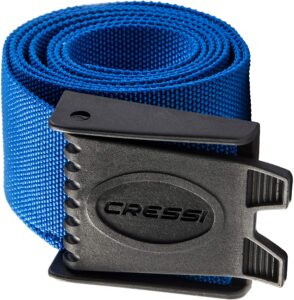
This weight belt is a must-have for every serious diver. Moreover, it’s constructed of tough woven Nylon and has a tough plastic buckle. It includes a quick-release buckle for instinctive and speedy emergency release.
The buckle pin is composed of lightweight and durable plastic. In addition, this is made of a high-stretch rubber that will maintain your weights comfortably in place throughout ascents and descents.
The stainless steel fast-release buckle allows for instinctive and speedy emergency release. In addition, it is made of a high-stretch rubber that keeps your weights comfortably in place throughout ascents and descents.
During your descent, the belt’s strong elastic qualities will flex and compress with your body and wetsuit. Moreover, it also extends and stretches as your body and wetsuit expand during ascent, ensuring that your weight belt is securely positioned around your hips.
[su_service title=”Scuba Max – Nylon Zippered Weight Belt” icon=”icon: star” icon_color=”#2D3092″ size=”32″ class=””][/su_service]
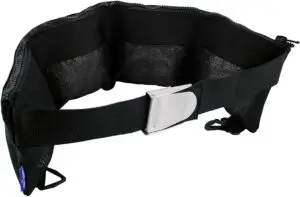
The compartments on this weight belt are made of thick quality nylon zippers. In addition, it has a weight belt with four pockets and an adjustable stainless steel buckle. So, each pocket may accommodate up to 5 pounds of weight.
Unfortunately, when you purchase this, the weight of the bag is not included.
It includes a mesh cover to allow for appropriate drainage and water movement. Moreover, every game bag has an accessory clip that holds the game. While diving, you can carry cameras and other equipment. So, it has a looped end for attaching auxiliary components.
The belt includes a lovely clasp and robust belt webbing that may be readily shortened to length if needed. Moreover, by using this weight belt, you may now drop elegantly and easily. But this is a well-known weight belt used by professional divers.
[su_service title=”Scuba Choice – Black Vinyl Coated Diving Weight Belt” icon=”icon: star” icon_color=”#2D3092″ size=”32″ class=””][/su_service]
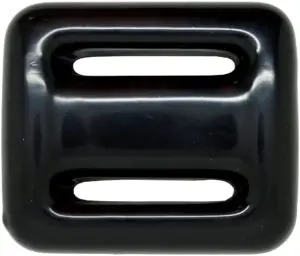
This weight belt weighs one pound. In addition, this is ideal for diving since it allows you to drop gradually underwater. So, this can simply be worn around your waist and is quite comfy.
This weight belt is constructed of lead, making it extremely robust. Moreover, when diving, this is a must-have because it might be tough to descend using only your body weight.
Diving can be more difficult without the assistance of additional materials. So, this weight will manage all of the necessary weight to ensure that you get underwater as smoothly as possible without jeopardizing your safety. Overall, when you purchase this weight belt, you will feel at rest.
[su_service title=”Engineered Edge – Dive Weight Belt” icon=”icon: star” icon_color=”#2D3092″ size=”32″ class=””][/su_service]
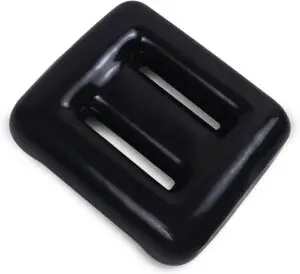
For any sort of diving, this weight belt may be threaded into any conventional weight belt or stored in the pocket of your BCD. When threaded through your weight belt, the curved edges provide comfort.
Furthermore, the vinyl finish is less abrasive to your wetsuit and will help your other diving equipment last longer. So, these are ideal for use with your diving weight belt, snorkel belt, or other rubber belts. They will also fit on a thick rubber belt.
Moreover, the vinyl-coated solid lead aids in the elimination of lead contamination. In addition, the covering prevents the lead from corroding or being pulverized into dust as a result of the weights colliding.
Types of Diving Weights
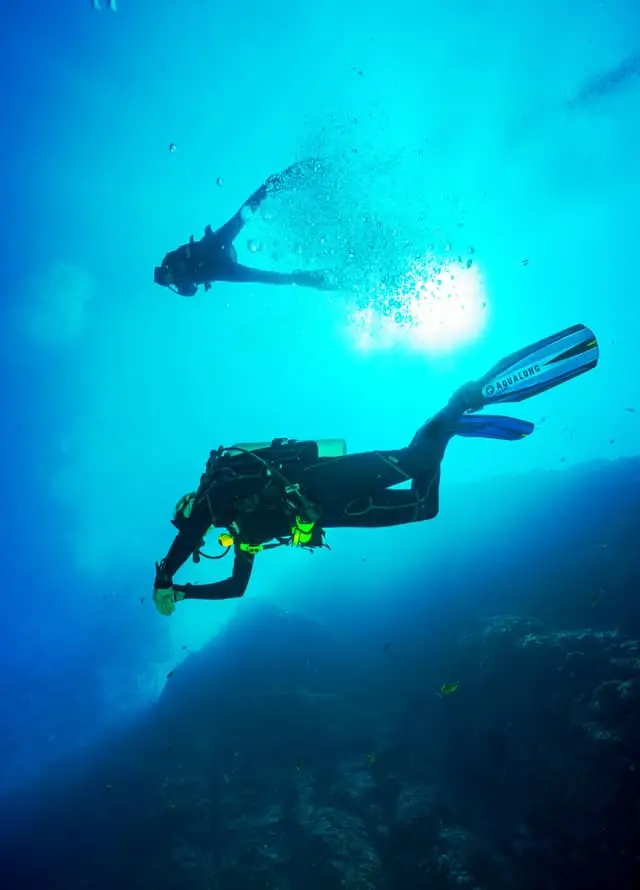
It may appear counterintuitive that a scuba diver must wear several pounds of additional weight during a dive. Moreover, the fact is that certain scuba diving equipment is quite buoyant.
This is why divers must wear weights to stay underwater. So, when it comes to scuba diving weights, personal preference is more significant than anything else.
With so many various types of diving weights on the market, choosing the finest dive belts and weights for you might be difficult.
➖ The Pocket Belts
Pocket diving weight belts are belts composed of regular nylon. And that includes multiple compartments. Moreover, these are simple to use; simply insert or remove the weights to regulate your buoyancy.
Another advantage is that they do not dig into your side, making them a more comfortable option than a lead block belt.
➖ The Lead Shot Belts
Diving lead shot belts are pouches or pockets packed with round-shaped lead shots until the appropriate weight is reached. So, the major advantage of employing this type is that they are highly comfortable.
Many divers continue to wear shot-style belts after switching to them. But depending on your choices, you may pick rectangular or cylindrical bags.
The disadvantage of this technique is that it might be difficult to adjust the weight when buoyancy changes. So, this implies you’ll need to acquire more weights to deal with it.
➖ The Lead Block Belts
The lead block belt is by far the most prevalent type of scuba diving weight belt. Moreover, this kind has two to three-inch nylon belts and a quick-release buckle.
These range in weight from 2 to 15 pounds. So, these are the cheapest scuba diving weight belts and are notorious for being unpleasant because of the weights digging into your hips.
➖ The Integrated Weight Systems
Integrated weight systems are the type found in some BCDs. In addition, this essentially implies that you do not need to wear weights in a separate belt.
When diving, they are also far more comfortable to wear than weight belts. So, the primary downside is that it adds size and weight to your BCD.
➖ The Brace Systems
Brace systems include a harness belt. But either has or does not have a backplate to which specific quick-release weights are attached to distribute weight across a larger area.
A significant advantage of brace systems is that they are ideal for divers with back problems. Moreover, this is because the weight is uniformly distributed. So, this is more pleasant than wearing a belt on your hips.
Steel backplate bracing systems also aid in appropriately distributing the tank’s weight. In addition, they also offer the advantage of allowing you to easily remove the pouches and weight bags in the event of an emergency.
➖ The V-Weights
Divers that use dual tanks frequently employ v-weights. It has a triangular or a v-shaped lead weight. So, this is sandwiched between two cylinders and keeps the weight off your lower back.
As a result, they may be more relaxed, and you may not need to wear weight belts. But the disadvantage is that you can’t immediately release v-weights if you need to make a speedy ascent. So, if you only have one tank and require a harness and backplate belt system, this is an excellent option.
➖ The Tail Weights
Tail weights are essentially the same as v-weights. So, they are substantially lower down on twin tanks and provide a lot more trim.
The benefit of tail weights is that they make it easier to maintain a steady horizontal position. This is because the weight is distributed equally much lower down.
In recent years, tail weights in the shape of end caps on diving air tanks have been manufactured.
➖ The Ankle Weights
Ankle weights are used to reduce the tension that diving may have on their back. And this is also to lower the fin and leg buoyancy. So, it will permit you to have a more relaxing and hence pleasurable diving adventure.
One of the most common issues that divers have is that their legs float upwards, making it considerably more difficult to manage buoyancy. Moreover, this is where ankle weights come in convenient.
However, you must ensure that the ankle weights fit snugly around your legs and that they have easy-release buckles.
Tips for Improved Buoyancy Control
✔️ Reduce your Weighing
Extra air in your BC will alter volume and buoyancy with depth, forcing you to yo-yo and limiting you from sustaining neutral buoyancy.
✔️ At the Safety Stop, Double-Check it
You must be weighted for impartial buoyancy at 15 feet. Additionally, this is at the end of your dive, not at the start. So, that implies you’ll be roughly five pounds overweight at the start of the dive.
✔️ Suspend a Weighted Bag
Hang a mesh bag with one-pound and two-pound weights from the boat at a height of about 15 feet. Moreover, begin the dive with around two pounds of your weight in a BC pocket.
But you can shift weights between pockets and bags at the safety stop, near the weight bag, to discover your ideal weighting.
✔️ Relax
Go limp to attain neutral buoyancy. So, any sculling with the hands or feet will result in an upward thrust.
✔️ Add and Remove Air
Before adding or removing more, you must wait a minute for the changes to take effect. The impact is not immediate.
✔️ Use your Lungs Instead of your BC
Change your buoyancy temporarily by retaining more or less air in your lungs.
This prevents you from interfering with the proper inflation of your BC. Hold breath with your chest, not your glottis, to allow pressure to escape.
Preparation for a Proper Scuba Descent
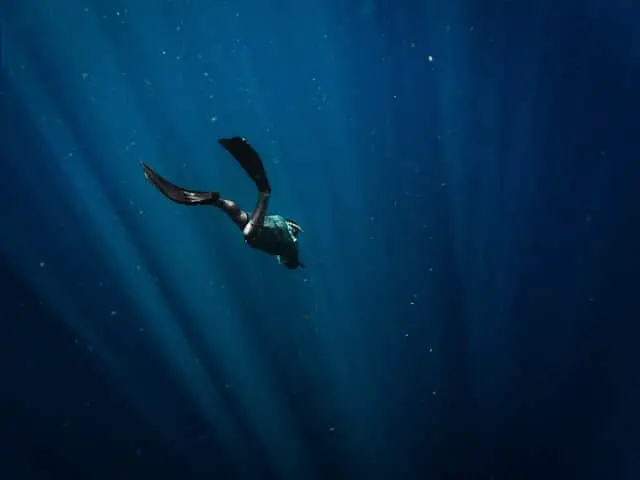
Before you begin your descent, take a few precautions to guarantee that you are physically and mentally prepared to do so.
Preparing for a dive before you go means you won’t waste time trying to fix a problem after you’ve already started.
❕ Examine your Equipment
Ensure you have everything you require for the dive before you get in the water.
Check that everything is in its right position and is safe. Nothing is more frustrating than attempting to descend only to discover that you’ve forgotten your weights.
❕ Examine the Situation
Review the current, both direction and force, once more before plunging into the water.
Considering which way the water is going may assist you to determine where to descend or whether you should postpone the dive until a later time or day.
❕ Examine the Surroundings
Look down once you’re in the water and just before you’re ready to drop to ensure you’re above your planned starting place.
Confirm the direction you’ll go after you’ve reached depth.
❕ Examine your Mind
You should have previously checked in with yourself to ensure that you are both physically and psychologically prepared for the dive and that you just feel good about it.
But, just before you’re ready to drop, take a few seconds to focus yourself and take a few deep, calm breaths. Certainly, make yourself available for the dive. So, concentrate your mind on the activity at hand.
❕ Make Direct Eye Contact
Ultimately, locate your companion and ensure you’re both ready to dive. And within an acceptable distance of each other before beginning your fall.
The Real Descend
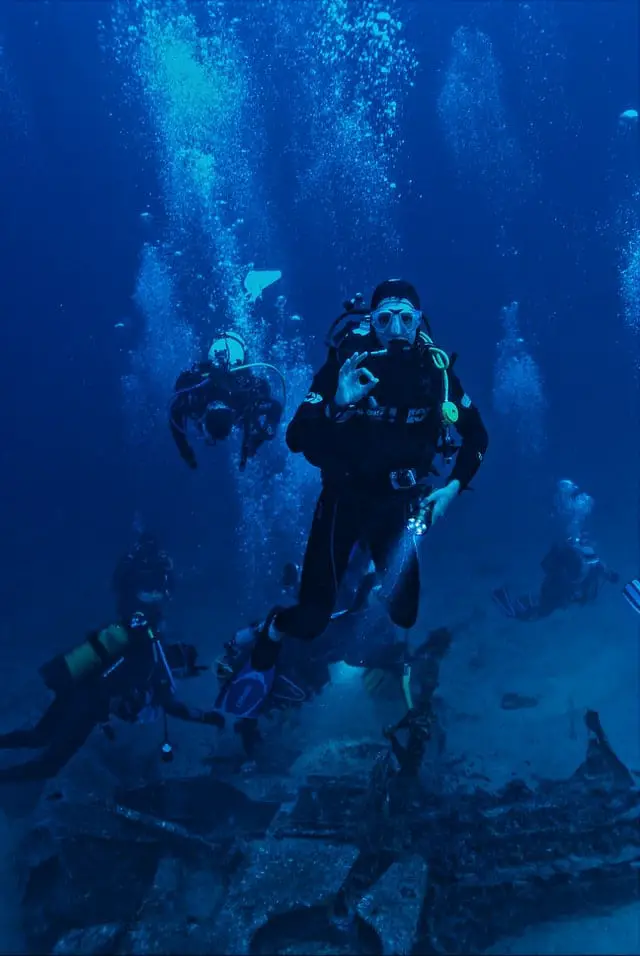
???? Let Air Out of your BCD.
Begin by removing all of the air from your BCD. You will float around eye level if you are appropriately weighted.
Exhale, pushing a little more air out than you normally would, and feel yourself sinking. So, once you’re a few feet below the surface, resume regular breathing.
But avoid taking too deep breaths, which will cause you to buoyant enough to float you back to the surface.
???? Adjust your Hearing
Equalize your ears “early and often,” as the adage goes. Begin equalization as soon as your head descends below the surface, and resume to do so at regular gaps as you descend.
The more frequently you equalize, the smaller force you need to use.
???? Look out for the Area and your Buddy
Keep an eye on your dive location as you begin to sink, make adjustments for any current. So, stay in communication with your companion.
You may begin softly finning in the appropriate direction after you’re approximately 10 feet below the surface, based on the current or how far you are from your dive spot.
You should stay vertical in the water till then. Moreover, this will not only aid your fall but will also maintain your sinuses above your lungs, assisting with equalization.
???? Fill your BCD with Air
As you descend, the air in your tank, and whatever else is providing buoyancy decreases, causing you to sink quicker and faster.
In addition, to prevent dropping too quickly, fill your BCD with modest quantities of air to moderate your descent.
???? Come to a Halt
As you get closer to the base of your desired depth, add a little more air to your BCD to complete a full hover.
Take a few deep breaths here to ensure that you’re properly buoyant. You should neither sink nor float up, and your depth should fluctuate just a little as you inhale or exhale.
Advice for First-Time Divers
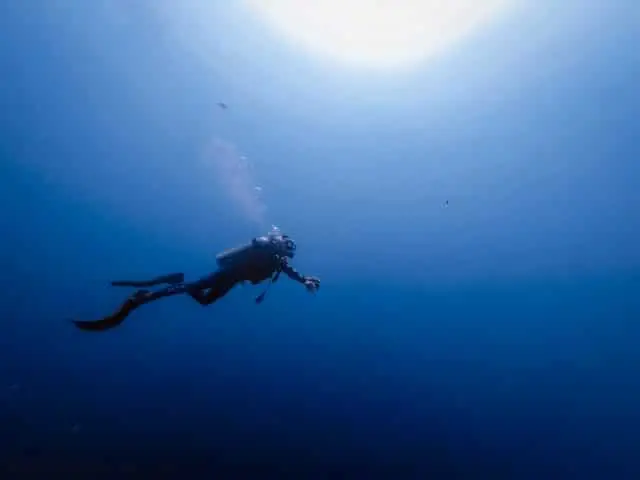
The earth is twice as big for divers as it is for average people. The water is so vast, there is so much to discover, and it is unlike anything you’ve ever seen before.
Diving is a fantastic activity because it allows you to immerse yourself in the ocean as if you were a fish swimming in the sea.
Nonetheless, mastering it needs practice and expertise because it is a difficult pastime that involves some major hazards.
???? Pick a Nice Day to Train
The weather might have an impact on your diving day. Waves can make reaching the point of immersion difficult and can also cause underwater currents.
If something doesn’t seem right, don’t force it and try again another day.
???? Ask Questions
If you have any remaining concerns, do not go underwater. Remember that you won’t be able to converse down there.
You must comprehend what you should do at all times. The data is for everyone’s peace of mind and protection, so ask your teacher anything is on your mind.
???? Breathe
Remember that you have an oxygen bottle in your back pocket, so breathe properly.
Nerves or intuition may cause you to hold your breath when diving, but be calm and breathe in and out gently as if you were on the surface.
???? Trust your Instincts
A human being is brilliant and can feel when things are not going as intended. So, analyze the problem and, if necessary, consult with your teacher.
???? Do not Touch Anything
Regardless of what you see in documentaries, the main guideline at sea is to gaze but not touch.
There are unknown fish and seaweed that may not be as harmless as you believe. So, take precautions.
???? Ascend Slowly
Do not rush back to the surface after the dive. Moreover, if you have an abrupt pressure shift, you may injure your lungs.
A good rule of thumb is to rise slower than the column of bubbles created with each breath of air.
???? Avoid excessive movement.
Water is approximately 800 times denser than air, thus any movement will need far more effort.
Try not to move too much to avoid becoming exhausted fast and to preserve some oxygen.
???? Be an Excellent Friend
Underwater, you only have one another, therefore always aim to be a nice diving companion.
Be aware of your own restrictions as well as your buddy’s diving level, health state, underwater communication, and equipment status.
???? Prepare Physically and Psychologically
Physical health and a positive mindset are essential for safe diving. Moreover, you must have a positive attitude and retain control of your nerves to deal with any problems that may emerge.
???? Examine the Equipment
Before each dive, you must double-check your team and your buddy. Two sets of eyes perceive more than one pair of eyes.
Check that the neoprene and glasses fit your body adequately.
Frequently Asked Questions
Q: How heavy should my diving weight belt be?
A: If you’re not sure where to start, start with 10% of your body weight.
Q: Why do scuba divers use weight belts?
A: Divers wear diver weighing systems, weight belts, or weights. Moreover, this is to counterbalance the buoyancy of other diving equipment.
Q: What exactly is a weight belt in scuba diving?
A: Weight belts are nylon belts that have lead weights attached to them. They fasten around your waist in the same way as traditional belts do.
Q: Is there a weight restriction for scuba diving?
A: There is no maximum weight limit for scuba diving. It is, however, a sport, and most sports need a certain amount of fitness to play. Moreover, to verify physical compliance, every active diver should get a medical checkup once a year.
Q: Why do divers use lead weights?
A: This is to accommodate for the increased buoyancy of our exposure suit and buoyancy control equipment.
Final Thoughts
When it comes to choosing the greatest diving belt or weight when scuba diving, it all boils down to personal preference. Moreover, the easiest way to choose one of these pieces of equipment is to test it in a swimming pool. So, this will allow you to choose which belt or weight is most comfortable for you.
When you try on diving belts or weights, you can figure out which type you’ll need.
